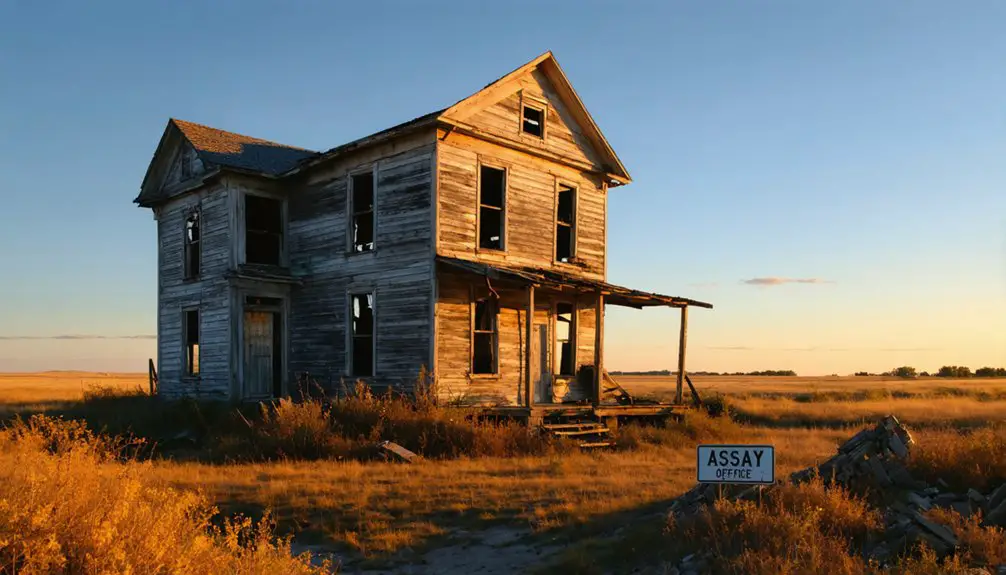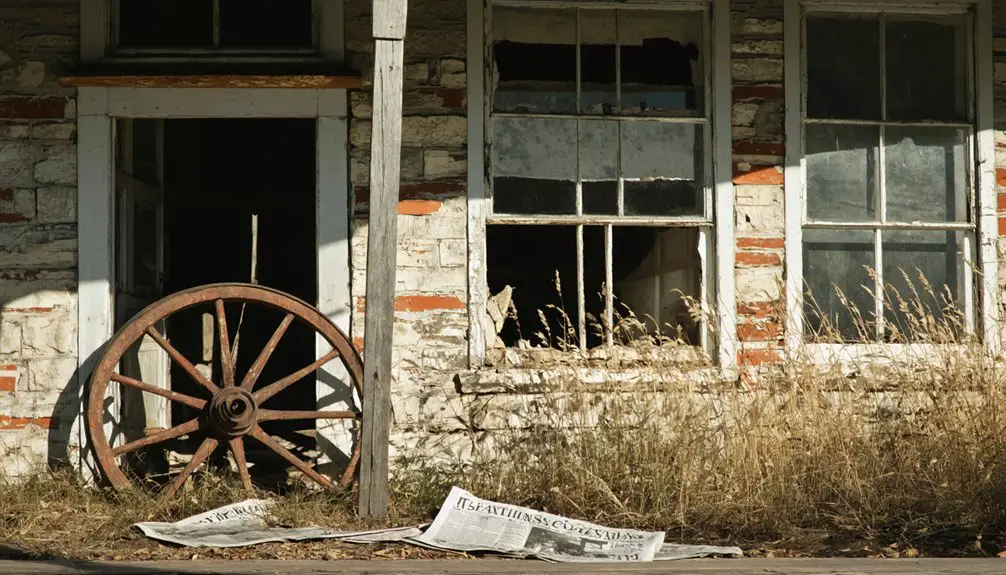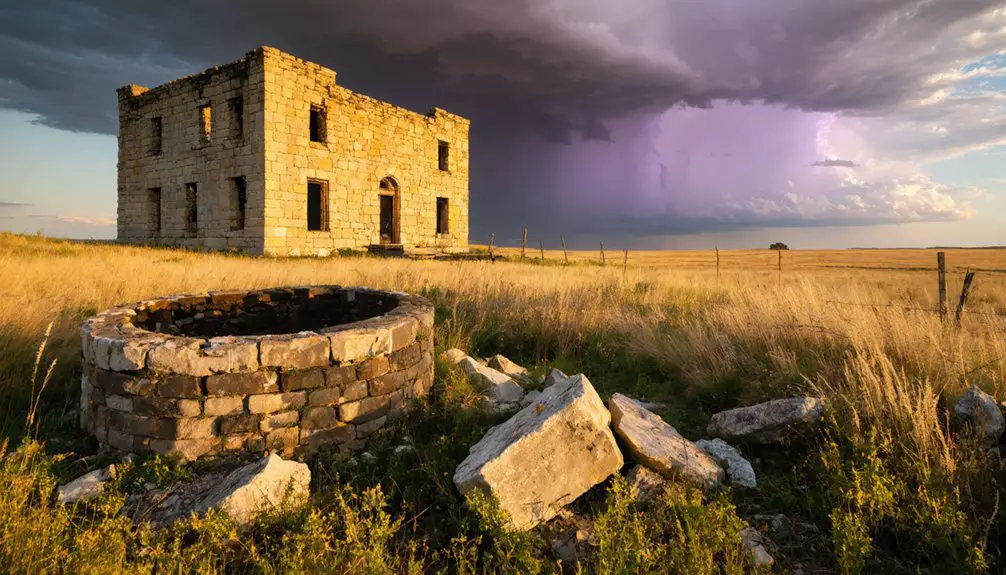You’ll discover the ghostly remains of Smoky Hill City along Kansas’s Smoky Hill River, where gold fever struck in 1899. Charles and Cyrus Holliday established this mining town, convinced of rich mineral deposits in the region’s shale. Despite boasting 75 residents by 1910 and two prominent mills, the town’s dreams crumbled when mining operations proved unprofitable. By the mid-1910s, the once-bustling settlement stood abandoned, its story echoing the boom-and-bust cycle of frontier ambitions.
Key Takeaways
- Founded in 1899 by Charles Holliday, Smoky Hill City peaked at 75 residents before becoming a ghost town by the 1910s.
- The town’s decline resulted from failed gold mining operations, with extraction costs exceeding profits from low-yield mineral deposits.
- Two main mills, Close Mill and Holliday Mill, operated from 1899-1902 before shutting down due to unprofitable mineral extraction.
- The town’s charter was revoked in 1905 after mining ventures failed, leading to mass exodus of residents and abandoned buildings.
- Located along Smoky Hill River, the ghost town represents Kansas’s short-lived gold rush era and failed mining speculation.
The Vision of the Hollidays: A Mining Town Takes Shape

While rumors of mineral riches along the Smoky Hill River had circulated for generations, it wasn’t until the 1890s that prominent Kansas capitalist Cyrus K. Holliday became convinced the area held valuable deposits of tin, zinc, and gold.
This belief sparked an ambitious economic strategy when his son Charles established Smoky Hill City in 1899. You can trace their calculated town planning through the swift platting and lot sales that followed, drawing settlers from defunct mining towns like Chetolah. By 1910, the town had reached a population of 75 residents.
The Hollidays’ vision leveraged their extensive railroad and banking connections to transform the north bank settlement into a regional powerhouse. With a post office established by April 1900, they’d created more than just another mining camp – they’d laid the foundation for what they believed would become a thriving economic hub. As Adjutant General of Kansas, Cyrus had already proven himself adept at organizing and mobilizing resources during the Civil War.
Gold Rush Dreams and Mining Operations
You’ll find the story of Smoky Hill City’s gold rush dreams centered around two ambitious mills – the Close and Holliday operations – which ran for three years processing shale through the costly Beam Process.
The ancient Indian trail route had originally guided hopeful prospectors to this location. Despite investing in machinery capable of processing 100 tons of ore daily and controlling over 12 square miles of gold shale claims, the syndicate’s efforts to extract meaningful amounts of gold proved futile.
The gold percentages in the ore were simply too low to justify the high extraction costs, and by 1903 the mining operations had ground to a disappointing halt. Like many seeking their fortunes during the Pikes Peak Gold Rush, these ventures ultimately failed to yield profitable returns.
Mining Mills and Operations
During the brief gold rush fever of 1899-1902, Smoky Hill City’s mining operations centered around two primary mills – the Close Mill and the Holliday Mill.
These ambitious ventures, led by Colonel Fred Close and Charles Holliday, aimed to process 100 tons of shale ore daily using the innovative Beam process from Denver.
The mining techniques focused on extracting precious metals from the region’s Cretaceous shale deposits, which reportedly contained traces of gold, silver, and about 20% zinc. The geologic formations consisted mainly of Greenhorn Limestone layers alternating with grayish shale.
Mill operations proved challenging, as the ore’s low mineral content couldn’t justify the high processing costs.
Despite controlling over 12 square miles of land and employing modern extraction methods, you’d find that both mills struggled to turn a profit.
Within three years, the dreams of striking it rich had faded, and the mills fell silent.
Dreams of Golden Riches
The origins of Smoky Hill City’s gold fever trace back to a curious mid-1800s scam involving Native Americans’ claims of tin mines along the river. This mining myth caught the attention of Charles Holliday and his father Cyrus, who’d become convinced the area held valuable mineral deposits.
You’ll find that gold fever spread quickly through the region, spurred by broader western gold discoveries and the earlier Pike’s Peak Gold Rush. The journey west to seek fortunes took up to several months by wagon.
Charles Holliday carried gold pieces to demonstrate his alleged findings, while the Smoky River Mining Company and local syndicates poured money into the dream. They even staged grand demonstrations and a ceremonial mine opening at “Camp Burleigh” to attract investors.
Despite their enthusiasm and promotional efforts, you’d have discovered only trace amounts of gold and zinc, making extraction unprofitable.
Failed Mineral Prospects
Despite massive investments and technological ambitions, Smoky Hill City’s mining ventures proved disastrous for investors and prospectors alike. You’d have found mineral extraction efforts yielding disappointingly low concentrations – about 20% zinc and mere traces of gold and silver per ton of shale.
Though Charles Holliday carried a gold specimen to entice investors, the reality fell far short of promises.
The economic impact was devastating. Even with two gold mills operating and the advanced Beam-process technology, mining costs consistently exceeded revenues. The syndicate’s 12 square miles of shale land couldn’t produce enough precious metals to sustain operations. Like many mining towns in Kansas during this era, the focus should have been on coal mining operations, which proved more profitable in other regions of the state.
Life Along the Smoky Hill River
Along the winding banks of the Smoky Hill River, diverse communities of Native Americans, explorers, and settlers made their mark on the landscape.
You’d find Comanche, Sioux, Kiowa, and Arapaho tribes gathering beneath towering cottonwood groves, utilizing the rich river ecology for hunting and fishing. The river’s abundant grasslands provided sustenance while serving as an essential transportation route. The tribes found plentiful wildlife including mule deer and coyotes roaming the fertile valley.
As you explore this cultural heritage, you’ll discover how the waterway transformed from the “Padoucas River” to the path of the Butterfield Overland Despatch. The river was first documented on a 1732 map by Jean Baptiste d’Anville.
The river’s significance peaked during the Pike’s Peak Gold Rush, when travelers sought fortune along the Smoky Hill Trail. Life here centered around the protection of frontier forts and the rhythms of Native American settlements until the railroad’s arrival in 1870 changed everything.
The Short-Lived Boom Years

When ambitious entrepreneurs Charles Holliday and his father Cyrus envisioned valuable mineral deposits along the Smoky Hill River in Ellis County, they sparked a brief but intense mining fever in the 1890s.
You would’ve witnessed dramatic economic fluctuations as prospectors discovered trace amounts of gold and zinc, leading Charles to establish a townsite in 1899. The community dynamics shifted rapidly as miners flocked to the area, and two gold mills began operations.
Like many mining communities, prospectors had to carefully navigate their claims to avoid confusion over mining rights and locations. You’d have seen the town’s official recognition with a post office in 1900, followed by the rise of supporting businesses.
But the dream was short-lived – by 1903, the harsh reality of low ore concentration and high extraction costs forced miners to abandon their claims, marking the end of Smoky Hill City’s golden aspirations.
From Bustling Settlement to Abandonment
The harsh economic realities of mining in Smoky Hill City became clear by 1903, as the low concentration of gold and zinc ore made extraction costs prohibitive.
Mining hopes crumbled in Smoky Hill City when low-grade ore deposits made operations too expensive to maintain.
You’d have witnessed a dramatic population decline as miners and their families abandoned their dreams of striking it rich, leaving behind empty homes and silent streets.
The economic collapse hit hard when the Close and Holliday gold mills showed minimal returns after three years of operation.
By 1905, Charles Holliday had no choice but to request the town’s charter be revoked.
If you’d visited during this period, you’d have seen the once-bustling settlement evolve into a shell of its former self.
The final residents departed by the 1910s, and the buildings succumbed to nature’s reclamation, marking Smoky Hill City’s permanent shift into a ghost town.
Historical Legacy in Ellis County

Deeply woven into Ellis County’s rich tapestry of frontier history, Smoky Hill City stands as a tribute to Kansas’s brief but passionate gold rush era.
You’ll find its legacy intertwined with the region’s cultural heritage, from the Native American influences that sparked the original mining rumors to the diverse settlers who carved out their dreams along the Smoky Hill River.
The town’s story reflects broader settlement patterns that shaped Ellis County, where military outposts, mining speculation, and transportation routes converged.
While the Holliday and Close mills failed to yield sustainable gold deposits, they established a foundation for community development that brought together Pawnee Indians and frontier settlers.
Today, Smoky Hill City’s remnants remind you of an ambitious chapter in Kansas history, where freedom-seeking pioneers gambled their futures on golden promises.
Frequently Asked Questions
What Happened to the Original Residents After the Town Was Abandoned?
You’ll find that the residents’ relocation stories varied, with many moving to nearby Ellis County towns, while others faced survival challenges seeking opportunities westward or joining agricultural communities in central Kansas.
Were There Any Notable Crimes or Lawlessness During the Town’s Existence?
Peculiarly peaceful, you won’t find documented crime statistics or law enforcement records from this period. While mining scams and land disputes likely occurred, there’s no evidence of significant lawlessness during the town’s brief existence.
What Was the Average Price of Lots When First Sold?
You’ll find exact lot sales prices weren’t documented, but given similar town valuations during Kansas’ 1899 gold rush period, lots likely sold between $50-200 depending on location and speculation.
Did Any Famous Personalities or Historical Figures Visit Smoky Hill City?
While you might expect famous visitors given the gold rush excitement, there’s no reliable record of notable historical figures visiting this short-lived town beyond Charles Holliday and local prospectors seeking their fortune.
What Native American Artifacts Have Been Discovered at the Townsite?
You’ll find Native tools including Smoky Hill jasper bifaces, side-notched arrows, and pottery with cultural significance. There’s also evidence of burial grounds containing remains and artifacts from Wichita, Arikara, and Pawnee tribes.
References
- https://legendsofkansas.com/smokyhill-kansas/
- https://www.hppr.org/hppr-people-communities/2015-06-24/a-remembrance-of-black-wolf-a-forgotten-kansas-town
- https://www.legendsofamerica.com/ks-smokyhillstrail/
- https://petticoatsandpistols.com/2017/03/20/smoky-hill-river/
- https://www.legendsofamerica.com/carneiro-kansas/
- https://legendsofkansas.com/cyrus-k-holliday/
- https://en.wikipedia.org/wiki/Cyrus_K._Holliday
- https://lostkansas.ccrsdigitalprojects.com/sites/lostkansas/files/private_static/2022-12/LT_EL_Chetolah_Wheeler.pdf
- https://core.ac.uk/download/pdf/33368282.pdf
- https://www.mininghistoryassociation.org/Journal/MHJ-v14-2007-Plazak.pdf



